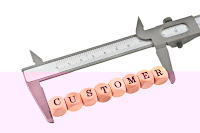
What is a customer worth to you?
We often have this discussion with our new clients. Very rarely do we find that they have truly thought through the real value of a customer. They are usually so focused on the present that they forget the future opportunities that are available to them.
When we think of the value of our customers we often think only of the order that is in front of us. Some of our clients are selling commodities and are getting orders several times a month, or year, and they will think often in terms of the annual spend that the customer has with them. That goes some way to answering the question accurately, but how long does the average customer stay with you? When you know that, you are in a position to accurately work out the true customer value.
So, average customer value is the Average order value multiplied by the number of times they order per year, multiplied by the number of years they stay with you, and averaged out across all your customers.
Why is this important? Simply because it makes it possible for you to decide how much you are prepared to spend to get a customer. Winning customers is really difficult, and most of us have to go to great lengths to achieve that. Most of the business owners that we meet just don’t appreciate the lengths that are really necessary, and, as a consequence, find it extremely difficult to win new customers. They often fall at the last, or last but one hurdle, which, if they only knew it, would be even more frustrating for them.
When you are trying to get someone to buy from you for the first time you have a major barrier to overcome. We call it inertia (Resistance or disinclination to motion, action, or change). Inertia comes from many motivations, including fear of making a mistake, uncertainty about the value of your offering, loyalty to existing suppliers, and good old procrastination. In order to overcome inertia you need to do something dramatic. Maybe it is creating an offer they can’t refuse, maybe it is showing a level of persistence that is beyond the normal human. Whatever it is, you need to do it, and it is impossible to justify the effort that takes when all you are looking at is the first order that the customer will place with you.
So, here’s the thing; for many businesses it makes good business sense to lose money on the first order (or the first few) as the long term benefits of dealing with that customer will make those initial losses look like an extremely good investment
We often have this discussion with our new clients. Very rarely do we find that they have truly thought through the real value of a customer. They are usually so focused on the present that they forget the future opportunities that are available to them.
When we think of the value of our customers we often think only of the order that is in front of us. Some of our clients are selling commodities and are getting orders several times a month, or year, and they will think often in terms of the annual spend that the customer has with them. That goes some way to answering the question accurately, but how long does the average customer stay with you? When you know that, you are in a position to accurately work out the true customer value.
So, average customer value is the Average order value multiplied by the number of times they order per year, multiplied by the number of years they stay with you, and averaged out across all your customers.
Why is this important? Simply because it makes it possible for you to decide how much you are prepared to spend to get a customer. Winning customers is really difficult, and most of us have to go to great lengths to achieve that. Most of the business owners that we meet just don’t appreciate the lengths that are really necessary, and, as a consequence, find it extremely difficult to win new customers. They often fall at the last, or last but one hurdle, which, if they only knew it, would be even more frustrating for them.
When you are trying to get someone to buy from you for the first time you have a major barrier to overcome. We call it inertia (Resistance or disinclination to motion, action, or change). Inertia comes from many motivations, including fear of making a mistake, uncertainty about the value of your offering, loyalty to existing suppliers, and good old procrastination. In order to overcome inertia you need to do something dramatic. Maybe it is creating an offer they can’t refuse, maybe it is showing a level of persistence that is beyond the normal human. Whatever it is, you need to do it, and it is impossible to justify the effort that takes when all you are looking at is the first order that the customer will place with you.
So, here’s the thing; for many businesses it makes good business sense to lose money on the first order (or the first few) as the long term benefits of dealing with that customer will make those initial losses look like an extremely good investment



